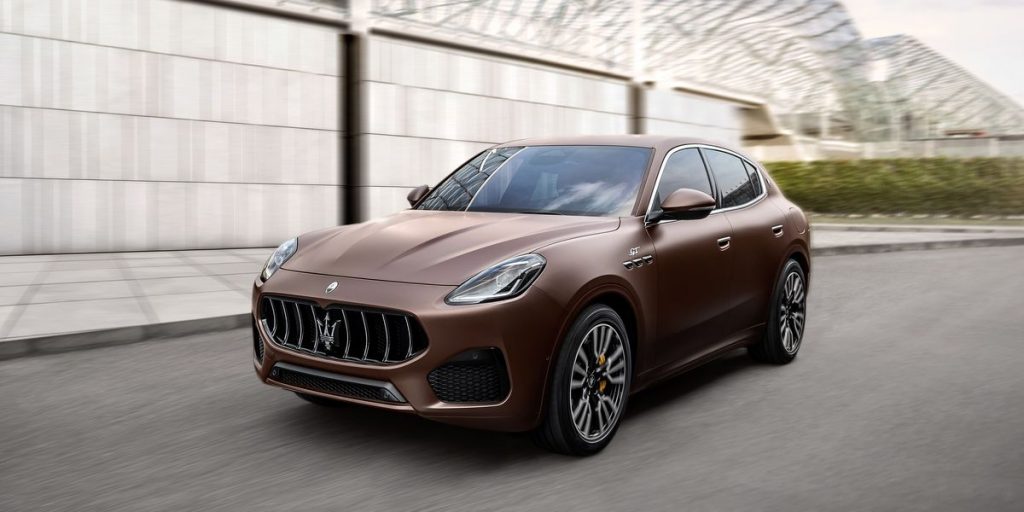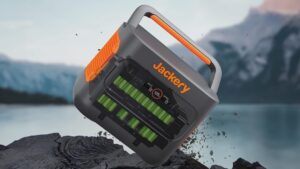2023 Maserati Grecale Targets the Porsche Macan

The idea of a Maserati SUV seems much less radical in 2022 than it did in 2016 when the Levante debuted, and the Italian brand has broader ambitions for the smaller, cheaper Grecale that is now being launched into one of the most competitive parts of the luxury market. The Grecale’s handsome but slightly familiar design is enough to show that one rival is being targeted more closely than others, however: The Maserati’s core mission is to persuade Porsche Macan intenders to defect.
The Grecale sits on an extended version of the Giorgio platform that underpins both the Alfa Romeo Stelvio and Giulia. At the bottom of the range, the Grecale GT has a 296-hp turbocharged 2.0-liter inline-four featuring 48-volt hybrid assistance. This is a version of the FCA Global Medium Engine, the same one found in Wranglers and Alfas. Above that is a slightly more powerful mid-ranker called the Modena, which has a 325-horsepower version of that same engine. It also adds adaptive dampers and a limited-slip differential at the rear. And at the top of the pile is the more compelling Trofeo, which uses a slightly detuned version of the Nettuno twin-turbocharged 3.0-liter V-6 developed for the mid-engine MC20 sports car (including the same pre-chamber ignition system), and it makes a claimed 523 horsepower. The Trofeo also gets a standard air springs and an electronically controlled limited-slip rear diff.
Most of our first drive in Italy was conducted in a Modena—appropriate given that Maserati reckons it will make up the majority of U.S. sales—but we also managed a briefer turn in the Trofeo. Spoiler alert: It’s the exciting one.
First impressions are strong. You would be hard-pressed to call the Grecale an especially original piece of design, especially its Macan-esque hood and headlights. Yet it is undeniably handsome from every viewing angle, with the styling team’s decision to eschew the customary gray lower body cladding that is often shorthand for “crossover” making it look more like a tall, elegant hatchback when viewed from the side. The obvious lack of ground clearance is another clear indication this is a car designed for road, not trail.
Getting into the cabin means encountering the mild surprise of touch-sensitive door release switches inside the apertures for what look like conventional handles. Small electrical release buttons on the interior door panels use the same technology, although the pared-back look these are intended to deliver is negated by the need for separate mechanical levers farther down to give redundancy in the event of power failure. Beyond that anomaly, much switchgear has been culled, with most functions controlled by twin touchscreens. They run Maserati’s new user interface system, which works cleanly and easily, although minor functions are often hidden in submenus. There is no conventional gear selector, as Maserati persists in using PRND touch buttons like an early ’60s Chrysler. Another neat detail is a round digital clock with reconfigurable faces.
The quality of interior trim is impressively high with a stitched leather dashboard facing and metal speaker grilles. Space is good for both front- and rear-seat occupants—the Grecale doesn’t feel any smaller than the Levante inside, with enough room for full-size adults to sit behind each other.
The impression of luxury takes a hit when the Modena’s engine starts. The Grecale isn’t the first four-cylinder Maserati (the Ghibli and Levante hybrids sold in other markets have them), but the the four-banger leaves little doubt as to what it is with a busy thrum at idle. Beyond that, the exhaust note finds a cleaner voice, but it never harmonizes into anything compelling.
On the plus side, performance feels respectably brisk and is delivered without apparent effort. There is little point in trying to reach the rev limiter, and in Drive the automatic gearbox always chooses to upshift well before the marked redline at 6000 rpm. But a broad spread of torque and the transmission’s intelligent use of its eight ratios deliver strong urge without the engine venturing from its midrange. The 48-volt starter-generator is claimed to add assistance to mask turbo lag, but a slight hesitancy was still obvious at lower engine revs when shifting gears under manual control—although Maserati deserves credit for the feel and weight of the metal shift paddles, a detail many automakers neglect.
The cars in Italy were all riding on Pirelli winter tires, despite warm and dry conditions on the day of our drive. Their limited grip made it easy to push the Modena’s front end into understeer, but also to sense that the front-rear handling balance is impressively benign. Maserati says the Grecale is primarily rear-driven with torque only transferred to the front axle when necessary, via an electronically controlled coupling. Stickier rubber should give the chance to experience that properly.
The Modena’s steel springs feel soft, certainly with the adaptive dampers in their Comfort setting, with noticeable roll during cornering and squat under acceleration. Selecting the firmer GT or Sport modes improved body control without making the ride unduly harsh, and both modes handled high speeds on a twisty stretch of Italian autostrada without drama. The steering is less impressive, with a springy resistance around the straight-ahead that denies any meaningful feedback, but the e-boosted brake pedal has a good weight and feel.
Whereas the Grecale Modena imparts competence rather than exhilaration, our shorter turn in the Trofeo more than reset the balance of thrills. The Nettuno V-6 engine is the undoubted star, and while it now sits above a wet sump and makes 98 fewer horses than in the MC20, Maserati’s claim of a 3.6-second zero-to-60-mph time still strikes us as entirely feasible. The Trofeo also gains a Corsa dynamic mode, and choosing either this or Sport gives a head-nodding torque bump on upshifts. Corsa also turned the active dampers too stiff for road use, with even minor imperfections sending a shiver through the Grecale’s structure, but it is possible to toggle the dampers softer while keeping the rest of the Corsa settings. In gentler modes, the air springs still feel pliant by segment standards, with the Trofeo’s body moving noticeably under bigger loadings.
Despite also wearing winter tires, the Trofeo’s steering felt much better than the Modena’s, with firmer and more natural weighting. The electronically controlled differential at the rear could also be felt working hard to maximize traction in lower-speed corners. Strangely, the brake pedal felt softer and less responsive than the one in the Modena, despite bigger six-pot calipers at the front. There was little resistance and a marked grabbiness at low speeds.
The Grecale Trofeo is considerably more exciting than the smaller-engine Modena, to no great surprise, but it also feels better resolved. Given the excellence of the Porsche Macan, we suspect that the four-cylinder car is going to have a tough time in the market, especially with a $64,995 starting price for the entry-level GT that positions it well above the base Macan.
But the most radical Grecale will almost certainly be the electric Folgore, which will be Maserati’s first attempt at an EV when it arrives next year. That one really will really feel like a culture shock.
Specifications
Specifications
2023 Maserati Grecale
Vehicle Type: front-engine, all-wheel-drive, 5-passenger, 4-door wagon
PRICE
Base Price: GT, $64,995; Modena, $78,895; Trofeo, $110,000 (est)
ENGINES
turbocharged DOHC 16-valve 2.0-liter inline-4, direct fuel injection, 296 or 325 hp, 332 lb-ft; twin-turbocharged DOHC 24-valve 3.0-liter V-6, port and direct fuel injection, 523 hp, 457 lb-ft
TRANSMISSION
8-speed automatic
DIMENSIONS
Wheelbase: 114.2 in
Length: 190.8–191.3 in
Width: 76.7–77.9 in
Height: 65.3–65.6 in
Passenger Volume (C/D est): 98 ft3
Cargo Volume: 19 – 20 ft3
Curb Weight (C/D est): 4425–4650 lb
PERFORMANCE (C/D EST)
60 mph: 3.6–5.3 sec
100 mph: 9.2–13.5 sec
1/4-Mile: 11.6–13.4 sec
Top Speed: 149–177 mph
EPA FUEL ECONOMY (C/D EST)
Combined/City/Highway: 19-20/17-18/23-24 mpg
A car-lover’s community for ultimate access & unrivaled experiences. JOIN NOW
This content is created and maintained by a third party, and imported onto this page to help users provide their email addresses. You may be able to find more information about this and similar content at piano.io




